It can be difficult for investors to choose between an open-ended fund and its investment trust version. They are likely to be run by the same team, to have similar holdings and to potentially charge the same fees.
Switching out of the open-ended fund to its close-ended sibling when a wide discount is available on the trust can be a good trade. Yet, the limit of this approach is that investors must have the conviction this discount will reduce over time.
Daniel Lockyer, senior fund manager at Hawksmoor Fund Managers, said: “My general view on whether it is right to switch from an OEIC to an equivalent investment trust is that there is no ‘free lunch’.
“For the investment trust to outperform the OEIC, investors have to have confidence that the discount will narrow. Are there conditions in place to see that discount narrow such as an acknowledgement from the board of directors that the discount is too wide and are prepared to do something about it, or a backstop event such as a continuation vote or similar realisation event?”
Therefore, Trustnet has asked experts which investment trusts they think offer a bargain to investors compared to their open-ended fund siblings.
Fidelity Special Values, which mirrors Fidelity Special Situations, was highlighted by two experts, as it currently trades on a 9% discount.
Rob Morgan, chief analyst at Charles Stanley, said: “While not remarkably high by current investment trust standards, it is more usual for the trust to trade closer to net asset value (NAV).”
While the portfolios are broadly similar, Bestinvest managing director Jason Hollands added that the close-ended version typically has a higher exposure to smaller companies and can also use gearing.
Performance of funds over 10yrs
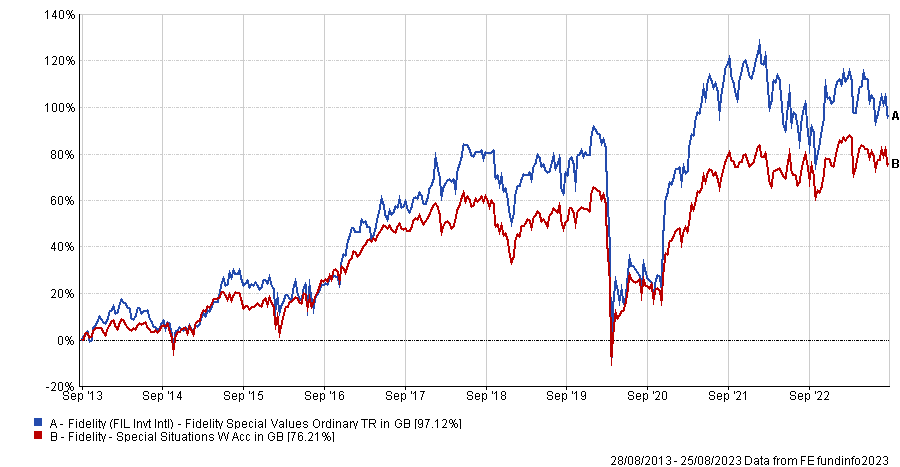
Source: FE Analytics
In terms of performance, the trust has outperformed its open-ended sibling over 10 years. However, the trust has been more volatile and experienced more negative periods in the past decade.
Both versions are managed by FE fundinfo Alpha Manager Alex Wright, who is a contrarian investor focusing on UK equities trading on cheap valuations, with limited risks of share price falls and where there is a catalyst for earnings growth.
Morgan also highlighted the Polar Capital Global Technology/Polar Capital Technology Trust tandem, as the discount of the latter stands at 14% despite being invested in an area that has done very well and having traded on a narrower discount historically.
Performance of funds over 10yrs
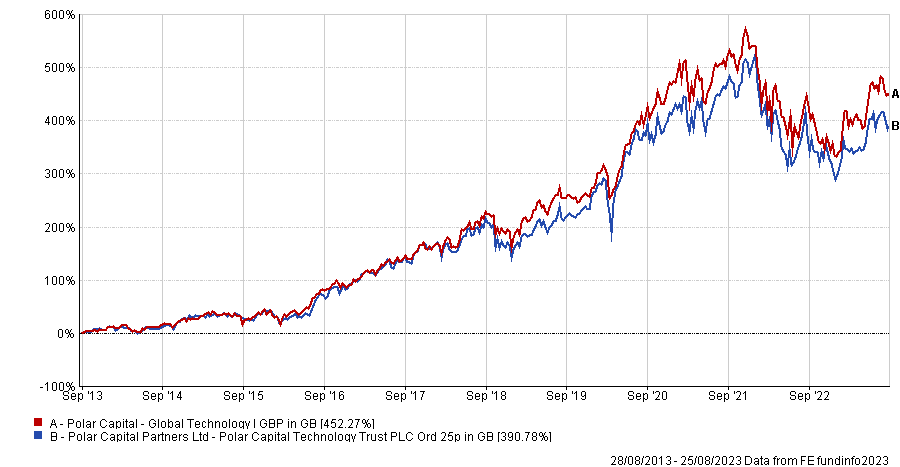
Source: FE Analytics
The fund is run by a team of managers specialising in different areas of the technology sector. They aim to identify changing industry trends and the businesses that are poised to benefit from them.
When it comes to emerging markets, Hollands had a preference for Templeton Emerging Markets Investment Trust rather than for its open-ended sibling FTF Templeton Global Emerging Markets, which are both managed by Chetan Sehgal and Andrew Ness.
He said: “In my view, a closed end structure is more optimal for exposure to volatile markets like these, as the manager won’t find themselves potentially having to liquidate holdings to meet redemptions in periods of market turbulence.”
Hollands also highlighted that the trust’s shares are currently trading on a 13.9% discount to NAV.
Performance of funds over 10yrs
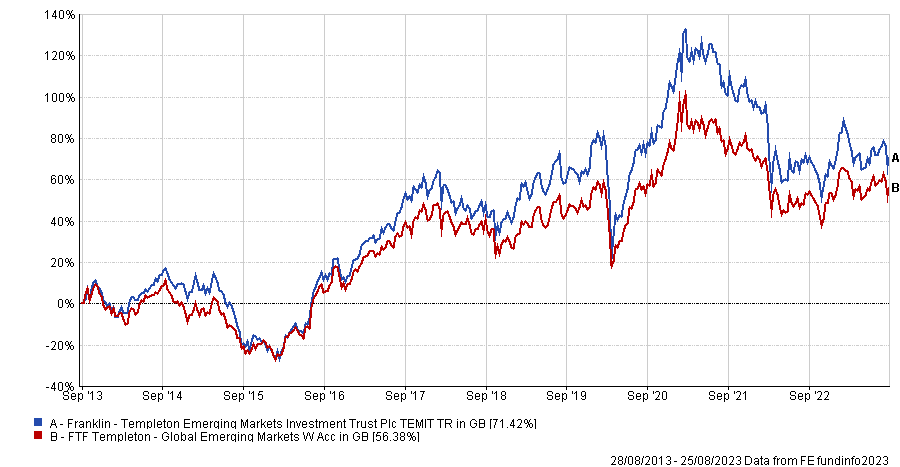
Source: FE Analytics
A less liquid part of the equity market is the small-caps space where experts have pointed at four trusts offering a better bargain opportunity than their open-ended versions.
Lockyer, for instance, believes that now is a good entry point to buy shares in Aberforth Smaller Companies Trust, which is currently trading on a 15% discount.
He said: “The portfolio trades on a price-to-earnings (P/E) multiple of 7.1x, a 34% discount to the Numis Smaller Companies Index’s 10.8x and has only been this cheap on two occasions since it launched in 1990; during the global financial crisis and Covid pandemic when 6x was briefly touched.
“If we are in a recessionary period, when average earnings have fallen 30% (the index as a whole not necessarily Aberforth’s), then the adjusted P/E ratio moves to 10.1x, still below the average P/E ratio of the portfolio since launch of 12.1x. Comparing the portfolio to global markets, the current P/E discount is 52% when historically it has been closer to 24%.”
Performance of funds over 10yrs
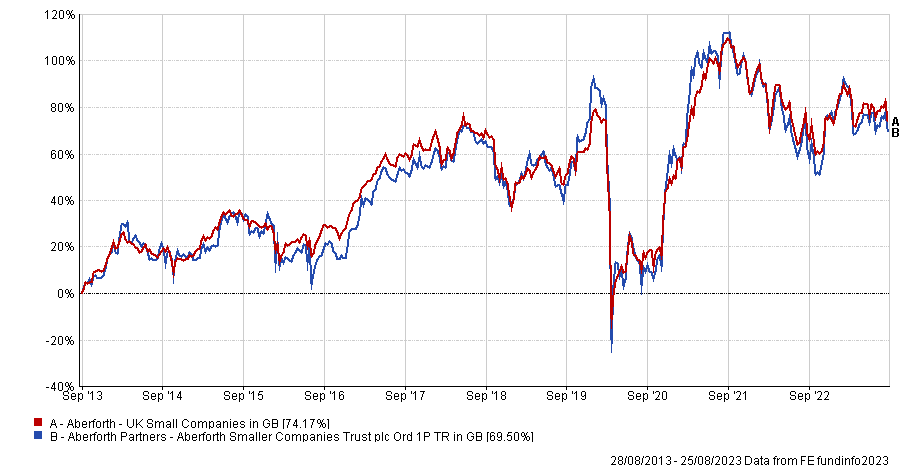
Source: FE Analytics
The portfolio is very similar to the open-ended version, Aberforth UK Small Companies, but the structure of the investment trust allows it to employ gearing (currently 4%).
The board has also committed to a growing dividend, paying a 3.1% yield based on today’s share price, and can top up the revenue reserves such that it now equates to 1.8x last year’s dividend, giving comfort that future dividends can be maintained.
Lockyer added: “The company is buying back shares regularly as it recognises the benefit of buying the whole portfolio on a substantial discount (equivalent to 6x P/E) is more accretive and has lower risk than investing spare cash into a new idea.”
Another potential trade to consider in the UK small-cap space highlighted by Hollands is to switch out of the Janus Henderson UK Smaller Companies fund into .
Performance of funds over 10yrs
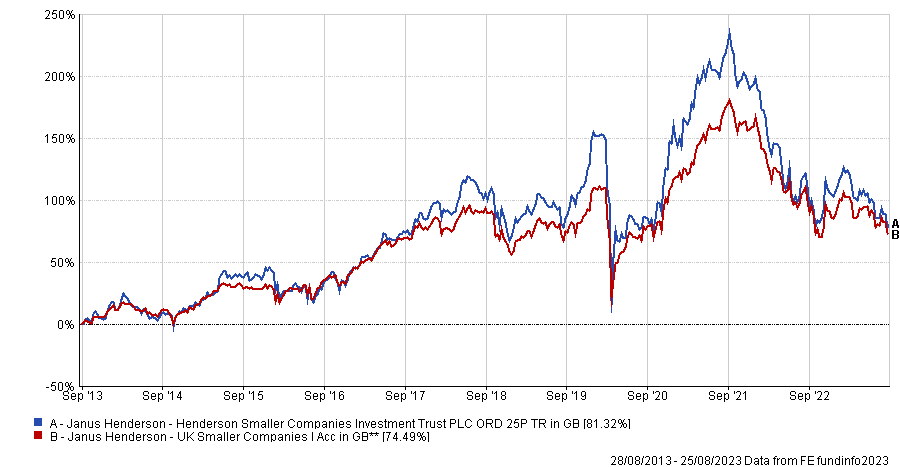
Source: FE Analytics
Hollands said: “Both portfolios are managed by veteran manager Neil Herman. Not only is the trust trading at a 13.8% discount to NAV, the ongoing charges of 0.44% on the trust is substantially lower than the 0.86% on the OEIC – so a move is a win, win.”
In the IT Global Smaller Companies sector, Anthony Leatham, research analyst of investment companies at Peel Hunt, encouraged investors in Baillie Gifford Global Discovery to move to the close-ended version known as Edinburgh Worldwide.
He said: “We see the open-ended Baillie Gifford Global Discovery Fund as being very similar to Edinburgh Worldwide, so we are surprised that investors have not yet taken advantage of the arbitrage between the two – sell the open-ended fund, and buy the investment trust. This could support a future re-rating of Edinburgh Worldwide.”
Performance of funds over 10yrs
Chart
Source: FE Analytics
Edinburgh Worldwide is sometimes likened to a small-cap version of the more popular Scottish Mortgage, as both portfolios mix public and private equities. The latter, which is also trading on a large discount, has its open-ended version known as Baillie Gifford Long Term Global Growth Investment.
Morgan highlighted that several Baillie Gifford funds have approximate equivalent trusts, which are currently on big discounts.
Finally, Lockyer mentioned Henderson Diversified Income, which is an approximate close-ended version of the Janus Henderson Strategic Bond fund. Although they are both managed by John Pattullo and Jenna Barnard, the portfolios are not identical twins as they display significant differences.
For instance, the close-ended portfolio taps into a broader investment universe, including high-yield bonds, senior loans and other floating rate notes that are not accessible via the open-ended fund. As a result, Henderson Diversified Income has a higher yield (7%) compared to the strategic bond fund (3.4%).
Lockyer said: “We believe certain parts of the credit market are attractively valued if the Bank of England is nearing the end of the interest rate hiking cycle, which would represent an opportunity in trusts like Henderson Diversified Income at a discount.”
In addition to the potential turnaround in the fortunes in credit market, the trust’s board has recently announced that it is considering Henderson Diversified Income’s future and that “an alternative investment process could offer greater scope to provide a more consistent return”.
Performance of funds over 10yrs
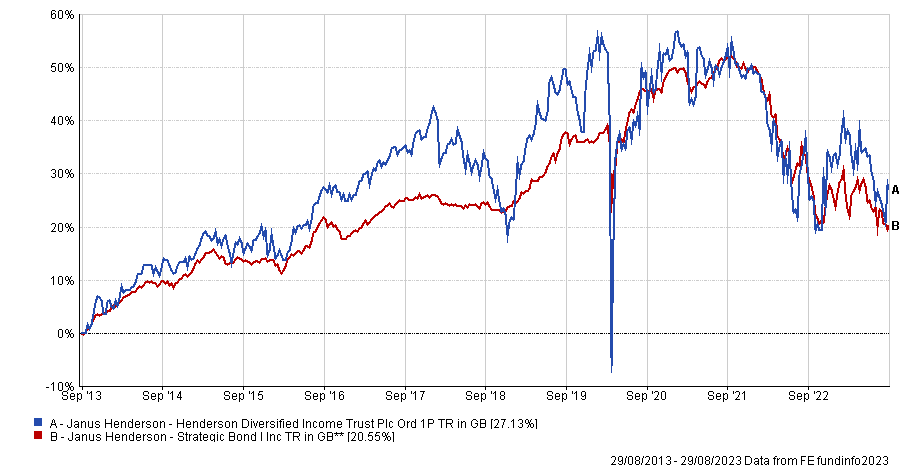
Source: FE Analytics
Lockyer added: “Of course, the outcome of the review may result in the status quo or a material change to the trust and mandate that may or may not narrow the discount, but the board’s statement suggests they are keen to do something about it.”
The trust is currently trading on a 10% discount, which is on the wider end of its historic range as it has traded at a consistent premium for much of its life.





